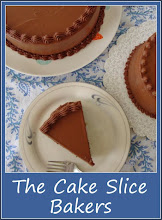

Yes it’s that time once again, time for another Daring Bakers Event. In case you hadn’t already guessed, this month’s challenge included potatoes! Four to be exact.
Tanna from ‘My Kitchen in Half Cups’ was this months host and she selected Tender Potato Bread from Home Baking: The Artful Mix of Flour & Tradition Around the World by Jeffrey Alford and Naomi Duguid. I wholeheartedly agree with the title, you certainly had to develop an ‘art’ for dealing with this bread, talk about sticky.
It was rather nice to have a challenge involving a baked savoury good as all my others have been sweet so far. I have never made potato bread before either and so was looking forward to it and yet I also found this daunting, especially since I had heard from other bakers that the dough was a bit hard to work with. It got to two days before the publication date and I knew I had to just knuckle down and do it, and what I lot of fun I had.
I was rather startled by how sloppy the potato base was, before adding any flour, but after adding the first of many mountains of flour, it did begin to resemble more of a dough. When it cam to turning the dough out onto the work surface, we were instructed to kneed it and work in additional flour. At this point I would have had more luck kneading a cake dough. It was so soft and sticky. I added more and more flour and it slowly transformed into a mountain of smooth stretchy dough. With relief I left it to prove and began to remove sticky mashed potatoes for all around my kitchen.
it did begin to resemble more of a dough. When it cam to turning the dough out onto the work surface, we were instructed to kneed it and work in additional flour. At this point I would have had more luck kneading a cake dough. It was so soft and sticky. I added more and more flour and it slowly transformed into a mountain of smooth stretchy dough. With relief I left it to prove and began to remove sticky mashed potatoes for all around my kitchen.
After proving, the dough is divided in half, one half was turned into a large loaf and the remaining half we were free to choose between making rolls or focaccia. We were also allowed to ‘unleash the Daring Baker within’ by flavouring or filling the dough as we saw fit.
For my loaf, I pressed it out into a rectangle and then spread it with a layer of rocket and pine nut pesto, before rolling up and placing in the loaf tin, proving and then baking.

With the remaining dough I chose to make focaccia and incorporated sun dried tomato pesto and olives into the dough, which also tinted it a lovely orange colour.

I was thrilled with the results. The loaf rose well and developed a lovely thin and crisp golden brown top with the swirl of pesto just peaking through. The bread felt quite heavy when I lifted it from the tin but was lovely and springy when pressed. Upon slicing, the dough is dotted with air holes and is extremely moist and soft in texture. It still retains a slightly sticky mouthfeel which reminded me strongly of gnocchi, not surprising really, considering they contain the same ingredients of potato and flour. The swirls of pesto make an attractive finish and add a wonderful flavour without the need of any additional toppings. It was a great accompaniment to a big bowl of lunchtime soup the following day.
Upon slicing, the dough is dotted with air holes and is extremely moist and soft in texture. It still retains a slightly sticky mouthfeel which reminded me strongly of gnocchi, not surprising really, considering they contain the same ingredients of potato and flour. The swirls of pesto make an attractive finish and add a wonderful flavour without the need of any additional toppings. It was a great accompaniment to a big bowl of lunchtime soup the following day.
The focaccia too turned out well, with a light crispy surface and a moist fluffy interior. The sun dried tomatoes added pretty orange streaks throughout the dough, although, I was a little disappointed that I couldn’t really taste them. The olives however gave strong bursts of musky saltiness whenever I bit into one. I think it would be great split in half and turned into a fancy cheese on toast.
I really enjoyed this months challenge and I loved how individual and unique the potato made the breads, so different from normal. I now just have the challenge of cleaning my entire kitchen. I seem to have got splodges of mashed potato and gluey fingerprints over every available work surface, still it wouldn’t be half so much fun if I didn’t get to make so much mess along the way.
Visit Tanna’s blog for the recipe and don’t forget to check out what the other Daring Bakers have created.
Tanna from ‘My Kitchen in Half Cups’ was this months host and she selected Tender Potato Bread from Home Baking: The Artful Mix of Flour & Tradition Around the World by Jeffrey Alford and Naomi Duguid. I wholeheartedly agree with the title, you certainly had to develop an ‘art’ for dealing with this bread, talk about sticky.
It was rather nice to have a challenge involving a baked savoury good as all my others have been sweet so far. I have never made potato bread before either and so was looking forward to it and yet I also found this daunting, especially since I had heard from other bakers that the dough was a bit hard to work with. It got to two days before the publication date and I knew I had to just knuckle down and do it, and what I lot of fun I had.
I was rather startled by how sloppy the potato base was, before adding any flour, but after adding the first of many mountains of flour,
 it did begin to resemble more of a dough. When it cam to turning the dough out onto the work surface, we were instructed to kneed it and work in additional flour. At this point I would have had more luck kneading a cake dough. It was so soft and sticky. I added more and more flour and it slowly transformed into a mountain of smooth stretchy dough. With relief I left it to prove and began to remove sticky mashed potatoes for all around my kitchen.
it did begin to resemble more of a dough. When it cam to turning the dough out onto the work surface, we were instructed to kneed it and work in additional flour. At this point I would have had more luck kneading a cake dough. It was so soft and sticky. I added more and more flour and it slowly transformed into a mountain of smooth stretchy dough. With relief I left it to prove and began to remove sticky mashed potatoes for all around my kitchen.After proving, the dough is divided in half, one half was turned into a large loaf and the remaining half we were free to choose between making rolls or focaccia. We were also allowed to ‘unleash the Daring Baker within’ by flavouring or filling the dough as we saw fit.
For my loaf, I pressed it out into a rectangle and then spread it with a layer of rocket and pine nut pesto, before rolling up and placing in the loaf tin, proving and then baking.

With the remaining dough I chose to make focaccia and incorporated sun dried tomato pesto and olives into the dough, which also tinted it a lovely orange colour.

I was thrilled with the results. The loaf rose well and developed a lovely thin and crisp golden brown top with the swirl of pesto just peaking through. The bread felt quite heavy when I lifted it from the tin but was lovely and springy when pressed.
 Upon slicing, the dough is dotted with air holes and is extremely moist and soft in texture. It still retains a slightly sticky mouthfeel which reminded me strongly of gnocchi, not surprising really, considering they contain the same ingredients of potato and flour. The swirls of pesto make an attractive finish and add a wonderful flavour without the need of any additional toppings. It was a great accompaniment to a big bowl of lunchtime soup the following day.
Upon slicing, the dough is dotted with air holes and is extremely moist and soft in texture. It still retains a slightly sticky mouthfeel which reminded me strongly of gnocchi, not surprising really, considering they contain the same ingredients of potato and flour. The swirls of pesto make an attractive finish and add a wonderful flavour without the need of any additional toppings. It was a great accompaniment to a big bowl of lunchtime soup the following day.The focaccia too turned out well, with a light crispy surface and a moist fluffy interior. The sun dried tomatoes added pretty orange streaks throughout the dough, although, I was a little disappointed that I couldn’t really taste them. The olives however gave strong bursts of musky saltiness whenever I bit into one. I think it would be great split in half and turned into a fancy cheese on toast.

I really enjoyed this months challenge and I loved how individual and unique the potato made the breads, so different from normal. I now just have the challenge of cleaning my entire kitchen. I seem to have got splodges of mashed potato and gluey fingerprints over every available work surface, still it wouldn’t be half so much fun if I didn’t get to make so much mess along the way.
Visit Tanna’s blog for the recipe and don’t forget to check out what the other Daring Bakers have created.



 Ingredients
Ingredients

 Ingredients
Ingredients


 Ingredients
Ingredients

 Ingredients
Ingredients


 Ingredient
Ingredient


 Ingredients
Ingredients




